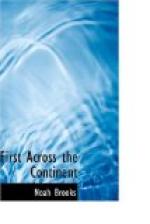On awaking the next morning, Captain Lewis found a large rattlesnake coiled on the trunk of a tree under which he had been sleeping. He killed it, and found it like those he had seen before, differing from those of the Atlantic States, not in its colors, but in the form and arrangement of them. Information was received that Captain Clark had arrived five miles below, at a rapid which he did not think it prudent to ascend, and that he was waiting there for the party above to rejoin him.
After the departure of Captain Lewis, Captain Clark had remained a day at Maria’s River, to complete the deposit of such articles as they could dispense with, and started on the twelfth of June.
Four days later, Captain Clark left the river, having sent his messenger to Captain Lewis, and began to search for a proper portage to convey the pirogue and canoes across to the Columbia River, leaving most of the men to hunt, make wheels and draw the canoes up a creek which they named Portage Creek, as it was to be the base of their future operations. The stream is now known as Belt Mountain Creek. But the explorers soon found that although the pirogue was to be left behind, the way was too difficult for a portage even for canoes. The journal says:—
“We found great difficulty and some danger in even ascending the creek thus far, in consequence of the rapids and rocks of the channel of the creek, which just above where we brought the canoes has a fall of five feet, with high steep bluffs beyond it. We were very fortunate in finding, just below Portage Creek, a cottonwood tree about twenty-two inches in diameter, large enough to make the carriage-wheels. It was, perhaps, the only one of the same size within twenty miles; and the cottonwood which we are obliged to employ in the other parts of the work is extremely soft and brittle. The mast of the white pirogue, which we mean to leave behind, supplied us with two axle-trees.
“There are vast quantities of buffalo feeding on the plains or watering in the river, which is also strewed with the floating carcasses and limbs of these animals. They go in large herds to water about the falls, and as all the passages to the river near that place are narrow and steep, the foremost are pressed into the river by the impatience of those behind. In this way we have seen ten or a dozen disappear over the falls in a few minutes. They afford excellent food for the wolves, bears, and birds of prey; which circumstance may account for the reluctance of the bears to yield their dominion over the neighborhood.
“The pirogue was drawn up a little below our camp, and secured in a thick copse of willow-bushes. We now began to form a cache or place of deposit, and to dry our goods and other articles which required inspection. The wagons are completed. Our hunters brought us ten deer, and we shot two out of a herd of buffalo that came to water at Sulphur Spring. There is a species of gooseberry, growing abundantly




